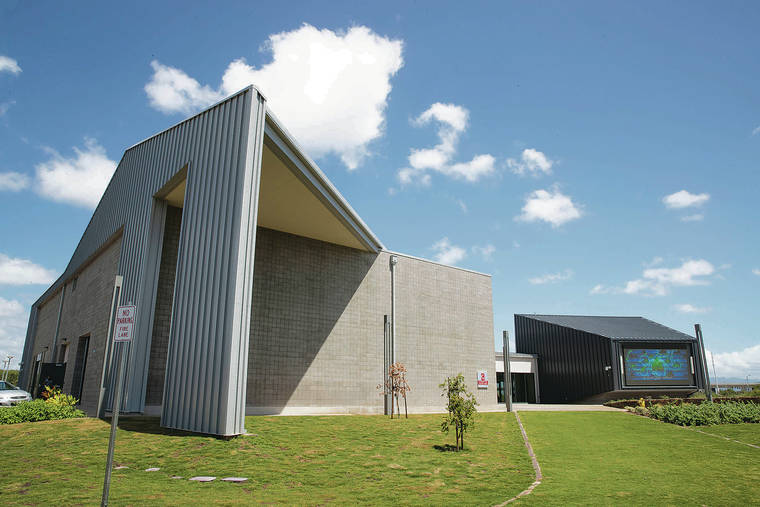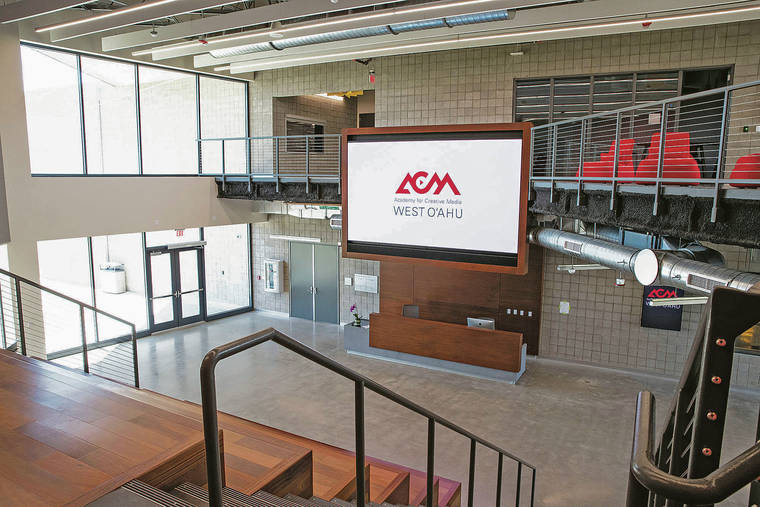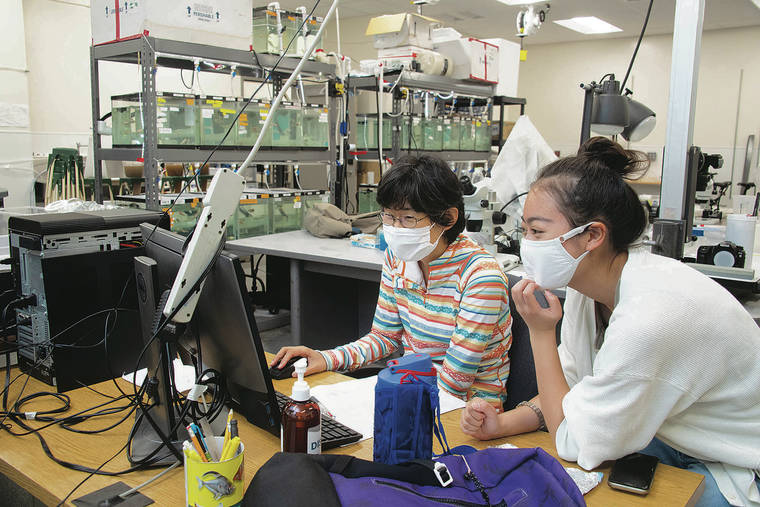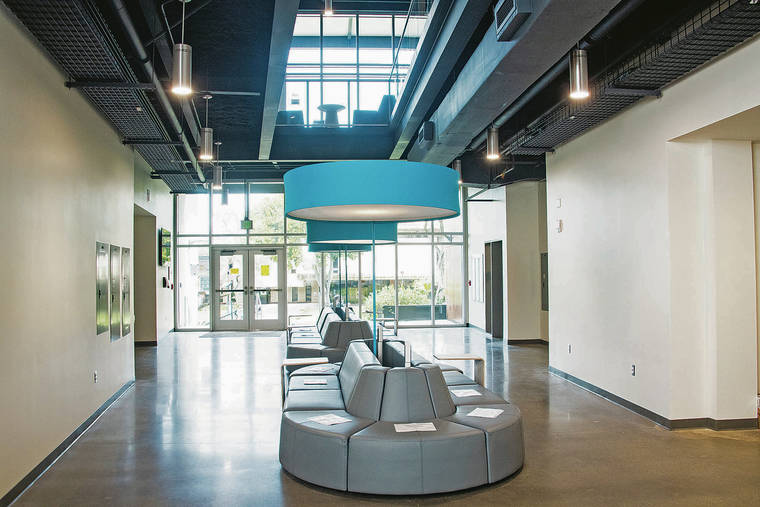University of Hawaii could lose control over decisions on construction, renovation and backlogged repairs across 10-campus system

CINDY ELLEN RUSSELL / CRUSSELL@STARADVERTISER.COM
The new University of Hawaii West Oahu Academy for Creative Media was built after UH President David Lassner was put in charge of all procurement and building decisions. The $37M facility boasts a 3,000-square-foot soundstage, post-production suites, state-of-the-art equipment and classrooms for media courses ranging from video production to game development.

CINDY ELLEN RUSSELL / CRUSSELL@STARADVERTISER.COM
The new University of Hawaii West Oahu Academy for Creative Media. Above, the lobby of the center can be seen.

CRAIG T. KOJIMA / CKOJIMA@STARADVERTISER.COM
Researcher Motoko Iwashita, left, with student Ju-Ling Chen, a volunteer undergraduate, work at the UH Manoa Life Sciences Building.

CRAIG T. KOJIMA / CKOJIMA@STARADVERTISER.COM
UH Manoa Life Sciences Building. Above is a lounge area on the first floor for students.




The University of Hawaii could lose control over decisions on construction, renovation and backlogged repairs across the 10-campus system if the Legislature fails to extend authorization for the UH president to continue acting as its chief procurement officer.
A House bill crossed over to the Senate that would allow the UH president to continue overseeing the university’s construction budget — an arrangement endorsed by the acting state comptroller as “efficient” — but faces possible death if it does not move by Friday.
State Sen. Donna Kim, chairwoman of the Senate Higher Education Committee, has planned a hearing on the bill for Tuesday afternoon, her office said. She did not respond to repeated requests for comment from the Honolulu Star-Advertiser on her thoughts on the latest version of House Bill 1067 Opens in a new tab.
Kalbert Young, who previously served as the state’s budget and finance director and is now UH’s vice president for budget and finance and its chief financial officer, said he has not been able to communicate with Kim about questions she might have about the bill.
“She hasn’t talked to me about what her problem is with the bill,” Young said. “We’ve offered to meet.”
In May 2013 the state Legislature authorized the UH president to temporarily serve as the UH system’s chief procurement officer through June 30, 2021.
Don't miss out on what's happening!
Stay in touch with breaking news, as it happens, conveniently in your email inbox. It's FREE!
A review of 102 UH solicitations for the first two years’ worth of construction projects by the state Procurement Office “found that the UH was conducting construction procurements in a compliant, efficient, and transparent manner,” Bonnie Kahakui, acting administrator of the state Procurement Office, wrote last month in testimony supporting HB 1067.
The bill would eliminate the June 30 sunset clause on the UH president’s construction and procurement authority, letting President David Lassner continue to oversee building practices that Young said don’t follow typical state procedures.
In the past five years, Young said, UH has been able to get construction projects built more efficiently “and faster than what I’ve seen with other state projects.”
“It’s better than anecdotal; there’s quantitative evidence that it is much more efficient and expedient for capital projects,” Young said.
Just since 2019 UH has finished or is underway on 15 projects worth $178,450, including UH Manoa’s $65,960,000 Life Sciences Building and the $34,480,000 Academy for Creative Media at UH West Oahu.
Smaller projects include $1.1 million to resurface UH Manoa’s tennis courts and $970,000 in repairs to UH Manoa’s Warrior Recreation Center.
At the same time, the UH system has a backlogged repair and renovation schedule estimated at more than $100 million annually, with $60 to $80 million just for UH Manoa.
If HB 1067 dies, responsibility for UH construction would revert to the state Procurement Office, which wants UH to retain control.
“There are reasons to suspect you’re going to lose a fair amount of efficiency that we’ve been able to build up over the last five years,” Young said.
In February, while HB 1067 was moving through the House, the General Contractors Association of Hawaii submitted testimony in support.
The GCA, Hawaii’s largest construction association, wrote that UH worked with the association to find ways “to improve the delivery of university projects. The University of Hawaii has been open to hearing feedback and identifying ways in which it can improve in the execution of important repair and maintenance projects and new construction by ensuring the process is efficient and transparent.”
Unlike typical government construction, UH uses a more simplified and efficient “design build” process that keeps everything within UH instead of the more traditional “design, bid, build” concept, which could require multiple reviews and change orders for unbudgeted costs, Young said.
He described a complicated and years-long effort to get a hypothetical $1 million school cafeteria built, starting with designs that might not fit with later construction realities and would likely require multiple requests for funding from the state Legislature as the project progresses, a process that could take at least three years.
Instead, using the design-bid process in-house, Young said UH does not have to award contracts to the lowest bidder and can work more closely with designers and builders on projects within budget that make sense for all sides.
And UH can lump together several projects, such as roof repairs for multiple buildings, instead of requesting individual funding for specific building projects from the Legislature.
“That is not an approach that is customary for the state,” Young said. “We will be back in a situation where we have to procure for individual building work.”
According to the current version of HB 1067, under the old system — before all construction and procurement were under UH’s control — the result was “a bifurcated procurement system at the university wherein a different set of rules and procedures applied depending on whether the procurement involved construction or construction related professional services for university construction projects. Procurements for construction or professional services … were required to comply with the Hawaii public procurement code and procedures governing state executive branch agencies, while procurements for goods and services were required to comply with the Hawaii public procurement code and university executive and administrative procedures governing university transactions.”
But since the Legislature gave construction oversight to UH, Young said, “the processes have been more efficient for both renovation work and new construction.”
UH CONSTRUCTION
>> $65,960,000:
UH Manoa Life Sciences Building (complete)
>> $34,480,000:
UH West Oahu Academy for Creative Media (complete)
>> $25,750,000:
Second phase of Kapiolani Community College’s Culinary Institute of the Pacific (60% complete)
>> $21,590,000:
UH Manoa Bachman Hall renovation (9% complete)
>> $10 million:
UH Manoa Gyms 1 and 2 (93% complete)
Source: University of Hawaii



